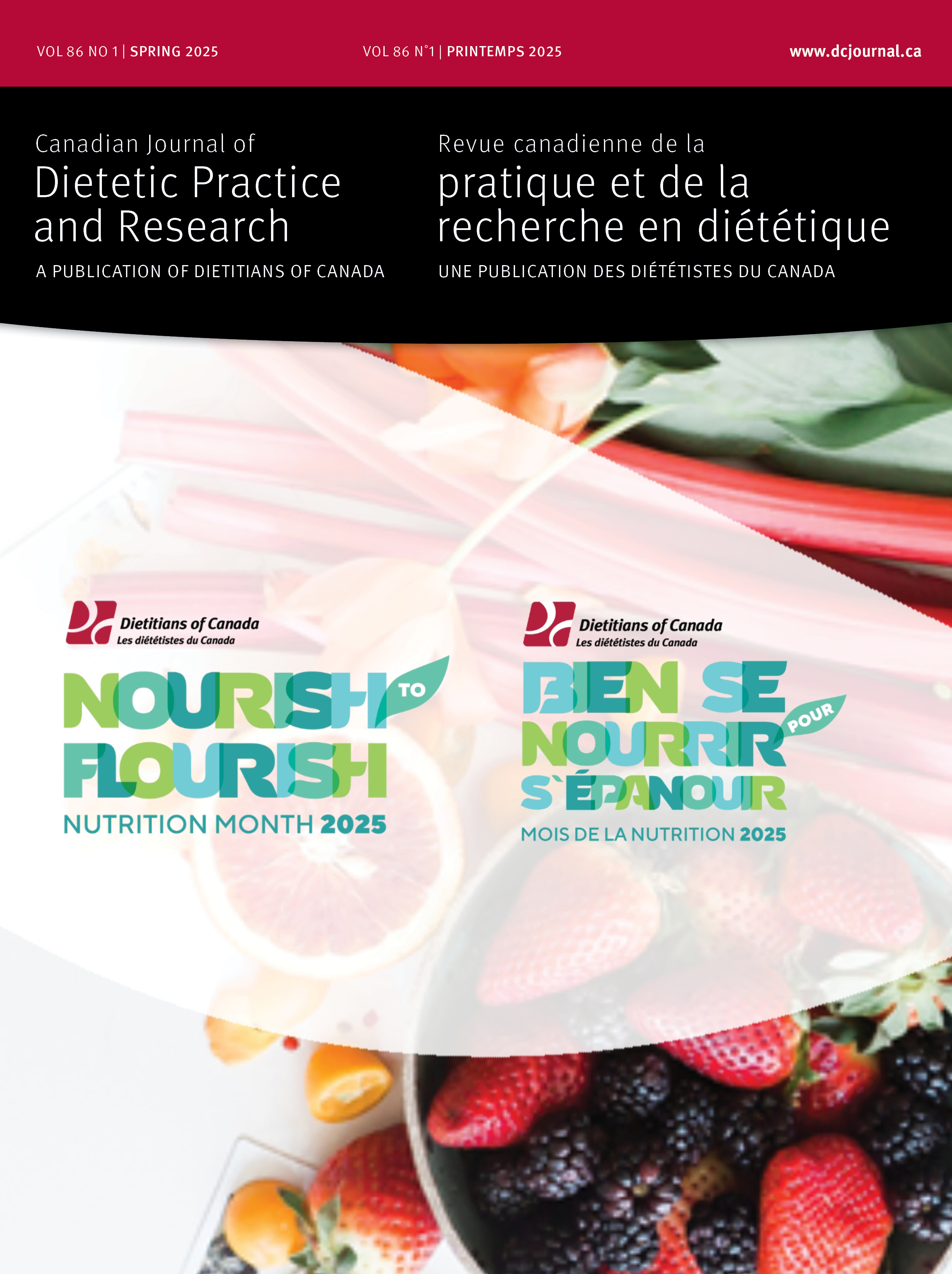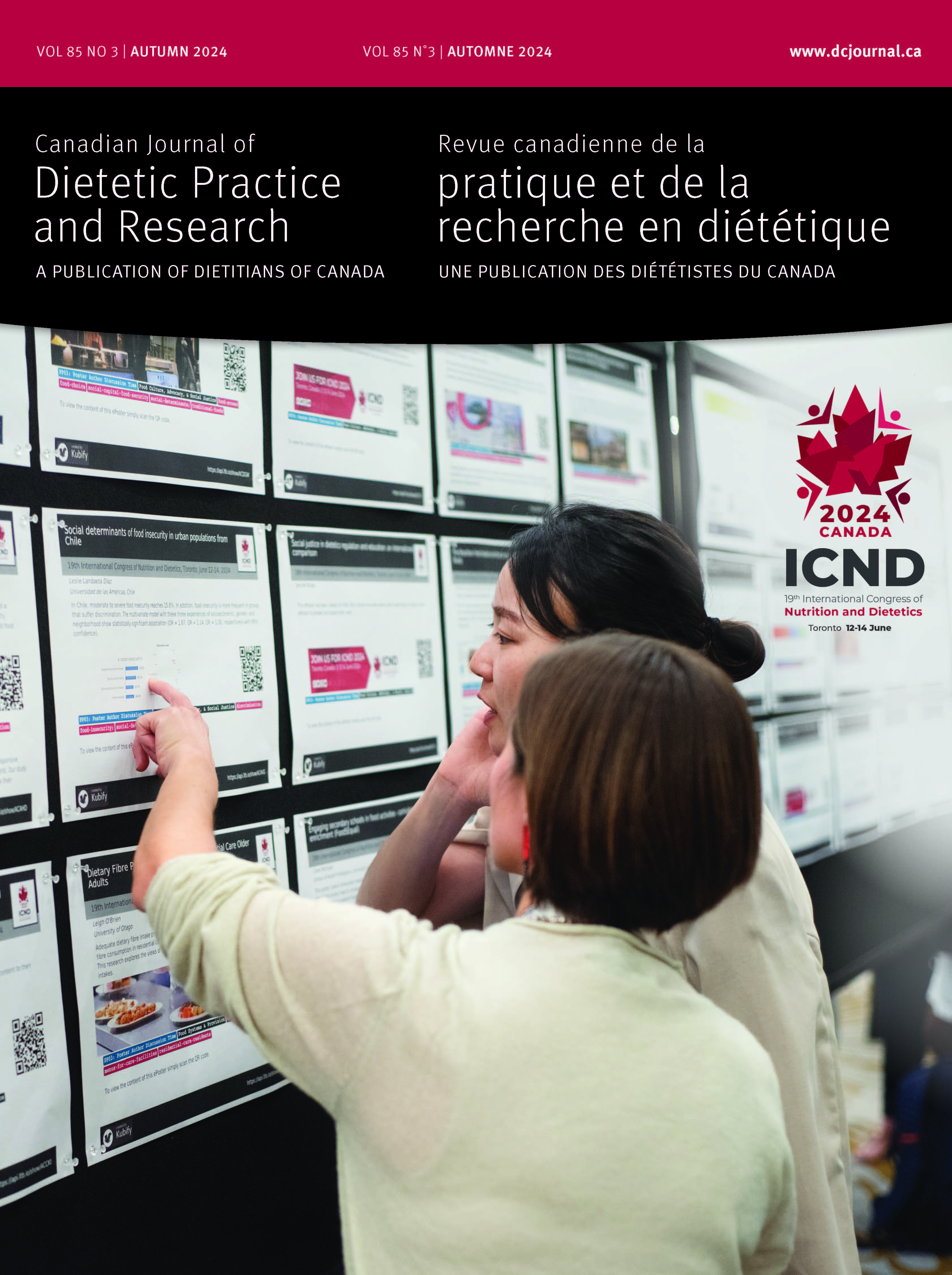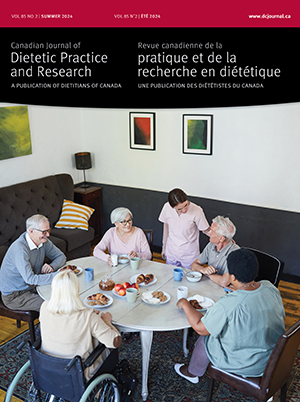Volume 74 • Number 4 • December 2013
Chair’s Message
Editor’s Message
Research
Purpose: This national study was conducted to examine healthy eating programs, healthy eating education, and the food retail environments of schools. Methods: A total of 436 Canadian schools were studied. Administrators completed a questionnaire designed to assess school healthy eating programs, healthy eating education, and food retail environment. The number of chain fast food restaurants, chain cafés/coffee shops, and convenience stores within 1 km of schools was measured using geographic information systems food retailer measures from DMTI Spatial Inc. and the Yellow Pages. Results: During the preceding year, 67% of schools had initiated healthy eating lunch programs while 18% had junk food-free days. The majority of schools offered cooking classes (59%) and healthy eating media literacy education (67%), while a minority offered gardening activities (15%) and field trips to farmers’ markets (27%) and grocery stores (36%). Fifty-three percent had a school cafeteria, and most had a school tuck shop (75%) and pop/juice vending machines (76%). Fifty percent had a chain fast food restaurant, 33% had a chain café/coffee shop, and 41% had a convenience store within 1 km. Conclusions: An important aspect of addressing childhood obesity will be improving the food environments of schools and their surrounding neighbourhoods, and providing healthy eating education for all students.
Purpose: Effectiveness was evaluated for a fruit and vegetable program developed to encourage Canadian elementary school children to eat the recommended number of daily servings. Also examined was whether the program modified children’s personal factors, perceived social environment, and perceived physical environment. Methods: A prospective, quasi-experimental trial was conducted to compare the eight schools receiving the intervention curriculum (Freggie Friday schools [FFS]) with six control schools (CS). A food frequency questionnaire was used to measure differences in fruit and vegetable consumption. Personal factors, perceived social environment, and perceived physical environment supporting fruit and vegetable consumption were assessed with an adapted version of the validated Pro Children study questionnaire. Results: Of the 942 children who completed the baseline assessment, 807 also completed the follow-up questionnaire (FFS, 450; CS, 357). A mixed-effects regression model indicated no significant intervention effects on fruit or vegetable consumption, snack food consumption, or knowledge or attitudes related to fruit and vegetable consumption. Conclusions: The results suggest that an intervention based on a single visit from an external group, followed by teacher-led programming, may be an ineffective method of eliciting dietary behaviour change in this population. Future programs may need to implement multicomponent intervention designs.
Perspectives in Practice
Better Living Health and Community Services developed a 12-week community-based nutrition information series (NIS) for people aged 55 or older. The purpose of this feasibility study was to describe briefly the process of developing and implementing the 12-week NIS and to identify the practicality and plausibility of the program in terms of its process and content attributes, using Thorncliffe Park community as the test site. A pre- and post-test design was used to identify changes in participants’ perception of their nutritional and overall well-being. Twenty-four participants who completed at least four sessions participated in the post-evaluation follow-up. Only participants’ perception of their eating habits demonstrated a significant, positive improvement (t24=2.1, P<0.05). The results suggest that the NIS has the potential to promote the health and well-being of community-living seniors. The development and implementation of the NIS provided considerations for program practicality. However, additional work is needed to examine the plausibility of the program in meeting its stated objective to promote awareness of nutrition as an important concept for healthy aging. Community-practising dietitians are instrumental in providing credible nutrition information to facilitate healthy eating in older Canadians.
Review
Because of widespread irregular lunch consumption by both children and adults, information on the effects of lunch on short-term cognitive functioning is relevant to public health. In September 2012, a MEDLINE search was conducted for studies in which the effects of lunch on cognitive performance were examined. Eleven experimental studies published from 1981 to 1996 were found and evaluated; all involved adults. In three studies, the effects of lunch and lunch skipping were compared; the remaining studies involved a determination of the effects of lunch size and lunch composition. Results of studies in which lunch was compared with no lunch indicate that lunch leads to potential impairment of some aspects of cognitive functioning in the early afternoon. Lunch size may influence cognitive functioning, with impairment more likely to occur after a large lunch than a small lunch. Furthermore, in comparison with low-fat lunches, high-fat lunches seem to result in slower but more accurate responses to some cognitive tasks. However, these suggestions must be viewed with caution, as they are based on only a few studies and are not thoroughly supported by high-quality evidence. In addition, results obtained with adults are not applicable to children. Thus, the potential effects of lunch need further examination in children and adults.
Report
Purpose: Bariatric surgery is accepted by the medical community as the most effective treatment for obesity; however, weight regain after surgery remains common. Long-term weight loss and weight maintenance may be aided when dietitians who provide perioperative care understand the causes of weight gain leading to bariatric surgery. In this study, the most common causes for weight gain were examined among prebariatric surgery patients. Methods: A retrospective chart review was conducted for 160 patients enrolled in a bariatric surgery program. Data were collected for 20 variables : puberty, pregnancy, menopause, change in living environment, change in job/career, financial problems, quitting smoking, drug or alcohol use, medical condition, surgery, injury affecting mobility, chronic pain, dieting, others’ influence over diet, abuse, mental health condition, stress, death of a loved one, divorce/end of a relationship, and other causes. Frequency distribution and chi-square tests were performed using SPSS. Results: Sixty-three percent of participants selected stress as a cause of weight gain, while 56% selected dieting. Significant differences existed between women and men in the selection of dieting and change in living environment. Conclusions: This information may allow dietitians to better identify causes for weight gain leading to bariatric surgery, and to address these causes appropriately before and after surgery.
Purpose: Healthy eating is a determinant of optimal growth, and schools provide an ideal setting in which to influence students’ diets. The Healthy Eating Guidelines Initiative (HEGI) was a partnership among education, health, and community stakeholders to develop and implement healthy eating guidelines across a school jurisdiction. An evaluation was conducted to examine the potential impact of the HEGI on the school food environment and students’ self-reported diets. Methods: All schools in the jurisdiction were invited to participate in the evaluation. Participating schools included elementary, middle, high, and mixed grades schools. A school environment assessment and a student questionnaire were used to collect data before and after the HEGI. Results: Twenty-two (71%) of 31 schools participated in the evaluation. The guidelines were successfully implemented in 17 of these 22 schools. Overall, a greater proportion of students reported healthier eating behaviours at the conclusion of the HEGI. In particular, a greater proportion of students in schools with cafeteria-style food service showed significantly improved self-reported dietary behaviours. These changes were not seen among students at schools with limited or no on-site food service. Conclusions: The findings are consistent with those of previous studies, and indicate that guidelines for a school jurisdiction can have a positive impact on the school food environment and students’ food intake. The HEGI shows promise as a strategy to promote healthy eating among students.
Purpose: The effect of an oral education intervention on nutrition knowledge was evaluated in new paramedic employees. The evaluation involved measuring knowledge of and attitudes toward nutrition and shiftwork before and after the directed intervention. Methods: A convenience sample of 30 new paramedic shiftworkers attended a 15-minute education session focused on nutrition management strategies. This matched cohort study included three self-administered surveys. Survey 1 was completed before education, survey 2 immediately after education, and survey 3 after one month of concurrent post-education and employment experience. Knowledge and attitude scores were analyzed for differences between all surveys. Results: Participants were primary care paramedics, 59% of whom were male. They reported that previously they had not received this type of information or had received only a brief lecture. Mean knowledge scores increased significantly from survey 1 to survey 2; knowledge retention was identified in survey 3. A significant difference was found between surveys 2 and 3 for attitudes toward meal timing; no other significant differences were found between attitude response scores. Conclusions: The education session was successful in improving shiftwork nutrition knowledge among paramedics. Paramedics’ attitudes toward proper nutrition practices were positive before the education intervention.










